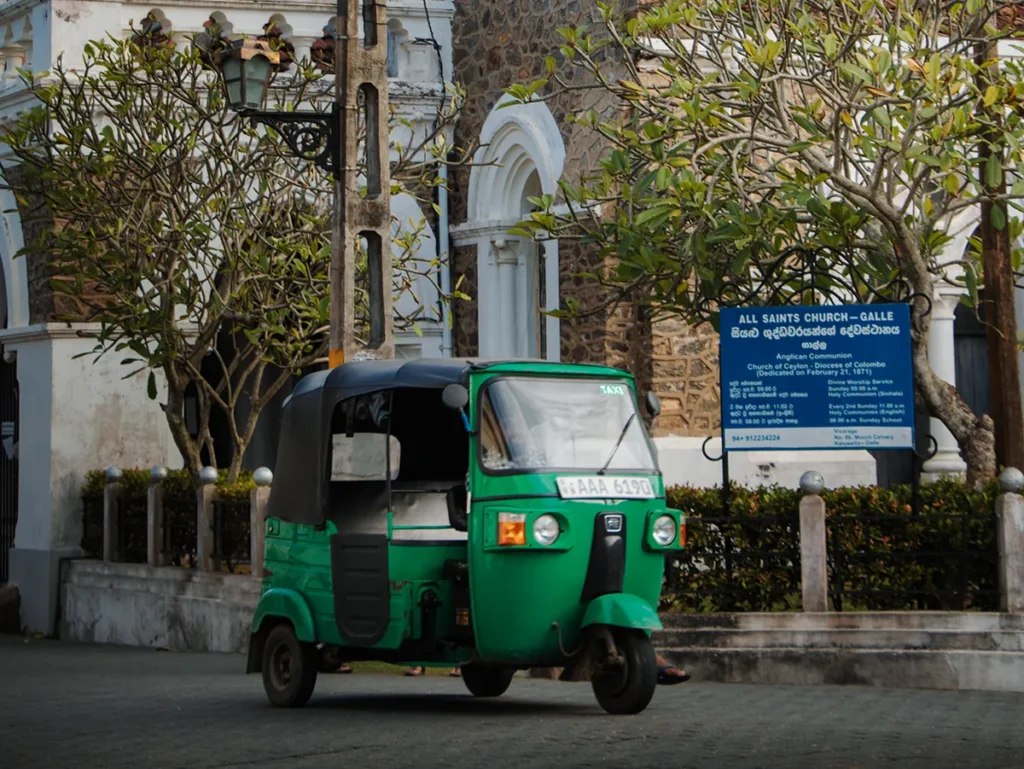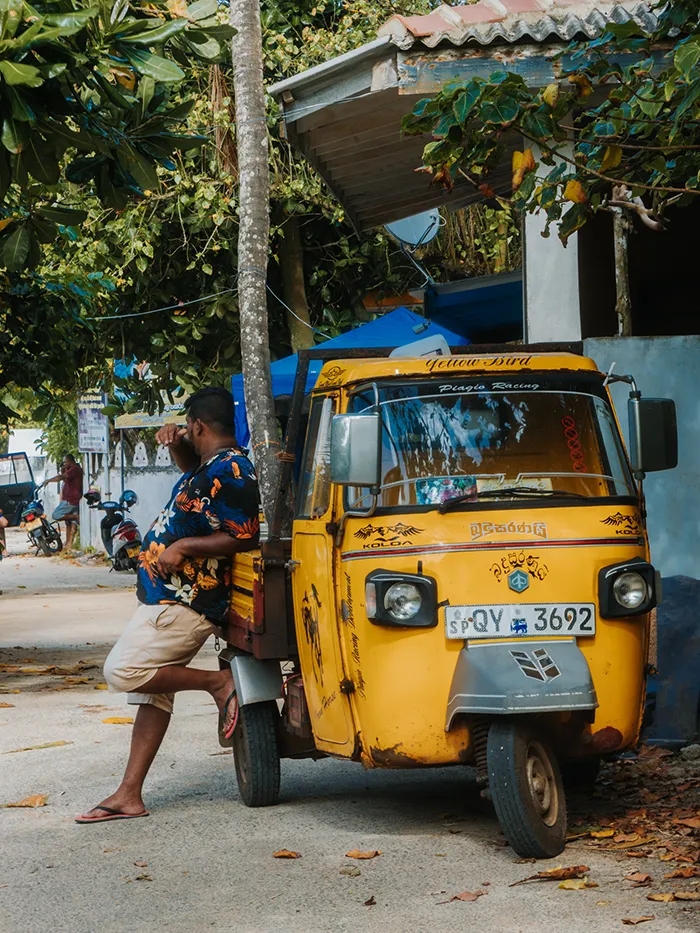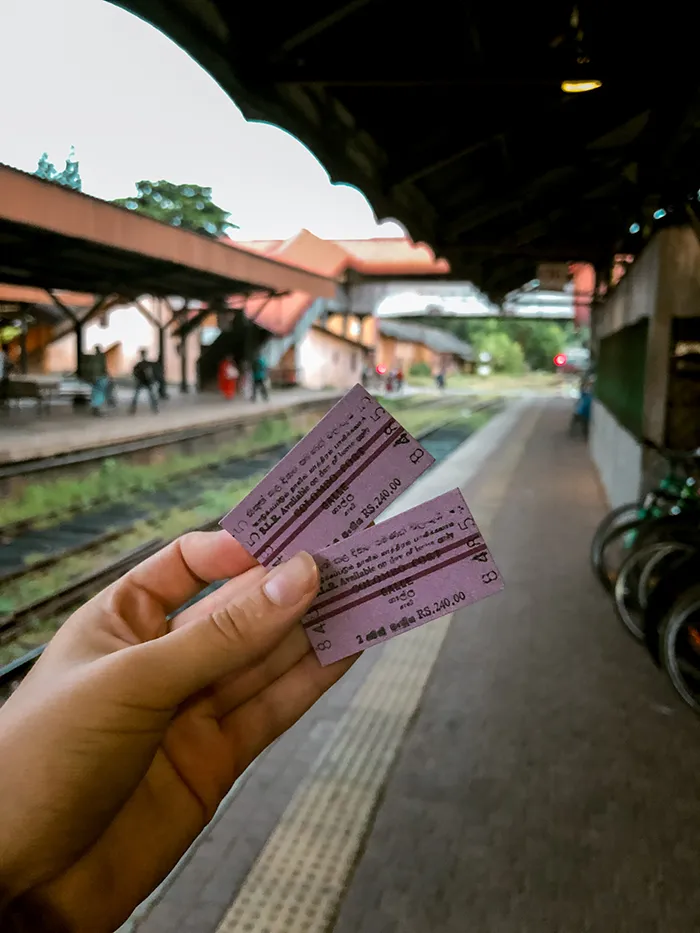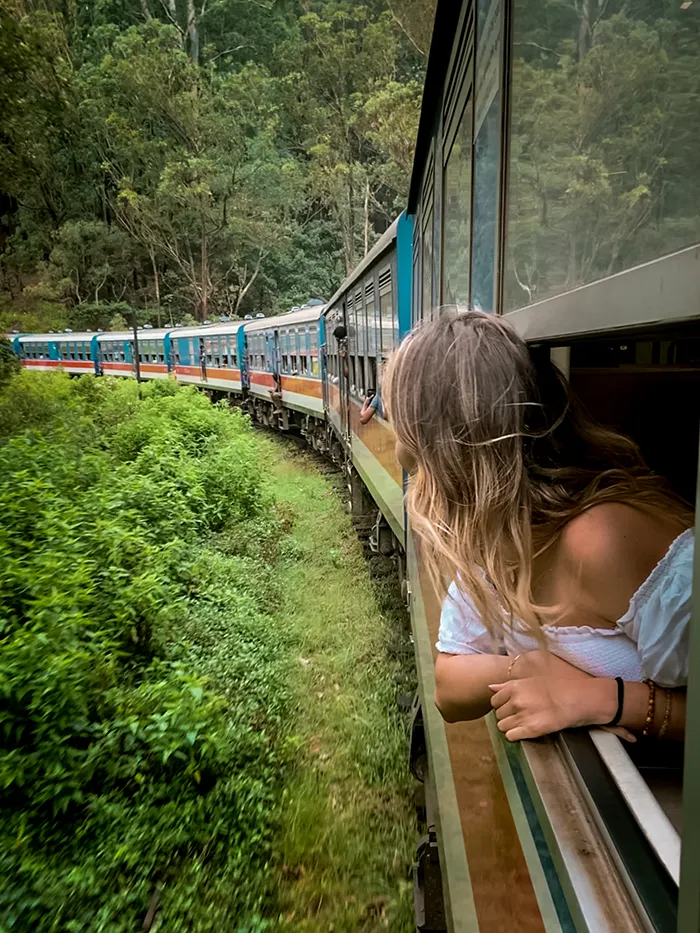Buses are the cheapest and fastest means of transport in Sri Lanka while trains are a more relaxed option and great for intercity trips. Tuk-tuks will take you everywhere in the city and if you have that extra buck, private drivers will show you all of the country’s hidden gems!
Let’s dive into all you need to know to get around in Sri Lanka!
1. City Buses – Private & Public 🚌
As a general rule city buses are divided into two: Red State buses and Blue Private buses.
Both usually work the same routes, but red buses are considered safer by locals. Although older and less comfortable, red buses are cheaper, don’t get too crowded and they drive a bit less like Schumacher (just a bit).
The blue buses are privately owned and drive like crazy! It is also packed since they simply want to make as much money as possible. Some private buses can be painted white, so in any case, if it’s not red, it’s private.

Unfortunately, buses are not a very safe mode of transport in Sri Lanka but they are indeed the cheapest way to get around the country.
🎟️ Tickets are also not purchased in advance, instead, payment is made directly to the conductors once inside. The costs vary depending on the distance, so you need to tell them your destination and they’ll let you know the cost. For state buses, distances less than 100 KM generally cost less than 150r.
Tips for taking buses in Sri Lanka as a tourist:
- You should always get a ticket, if you don’t receive one, ask for one.
- Conductors might want to overcharge you. Ask a local beforehand what the price of the ride should be.
- Some conductors “forget” to give change, so it’s better to pay for the exact fare.
- There is almost no space for luggage on most city buses.
- You can easily travel by bus during the day, but you’ll rarely find a city bus running at night.
As for where to catch the buses, chances are you won’t be able to figure this out by yourself… You can ask the information booth at the bus stations but also seek help from local residents to know where to catch the bus you’re looking for – they are super helpful and kind and will definitely stop to explain to you what to do!
Once at the correct spot, stick an arm out to flag down the bus. Be aware that sometimes, drivers don’t stop completely, instead slowing down just enough to allow you to jump aboard.
2. Intercity Bus 🚍
Intercity buses in Sri Lanka can also be either State or Private and they usually start and end their routes at bus stations.
Some bus stations are proper buildings but sometimes they can also be simply a large parking lot… In any case, the principle is the same: no ticket offices or reservations. You go to the station, find the bus you need, and just hop inside.
For a more comfortable ride with reserved seats and A/C, you can choose between one of the coach services that operate around the country such as NCG Express and Super Line Travels.
Super Line Travels has a website where you can book the tickets in advance. NCG Express’s best booked via phone – just state where you want to go, from where, and when. They will assign you a seat number and let you know where to wait for the bus and at what time.
Note: You’ll have a reserved seat but don’t get surprised when the driver starts picking up people on the way who will spend the whole journey standing in the bus aisle.
🎟️ The fares vary a lot depending on the journey, but here are a couple of examples from August 2022:
- Super Line Travels: Colombo to Ella – 2,740.00r
- NCG Express: Ella to Colombo – 2,900.00r
3. Ride-Sharing Apps 🚕
Uber and PickMe are the most used and most popular ride-sharing apps in Sri Lanka, although we noticed they’re mostly used in big cities and PickMe is usually cheaper and has more drivers.
Tuk-tuks are also available in both apps and it’s a great way to know how much you should pay for a tuk-tuk ride before negotiating with a driver.

🎟️ The fares vary a lot depending on the journey, but here are a few examples from August 2022 from the PickMe app:
- Galle Fort to Unawatuna Beach (15 to 20-minute ride): 640r by tuk-tuk & 920r by car
- Dambulla to Kandy (2-2:30 hours ride): 8930r by tuk-tuk & 10700r by car
Also see: Best 9 Things to Do in Unawatuna
4. Tuk Tuks or Rickshaws 🛺
One of Sri Lanka’s most characteristic sights and the staple means of short-distance travel in the country, tuk-tuks or rickshaws are a great way to experience the country!


Except in Colombo, tuk-tuks are unmetered and the fare will be whatever you negotiate with the driver (that’s why checking Uber and PickMe is a great way to know if they’re overcharging you and what should be a reasonable price for that journey).
Hot tip: keep in mind that the longer the journey, the lower the per-kilometer rate should be.
Bargaining is a thing in Sri Lanka so the first price offered by the driver is usually overpriced. Take your chance at haggling and if you can’t agree on a decent fare, don’t be afraid to go for the next driver – there’ll always be one keen to take your ride.
Keep in mind that you should be fair too. Sri Lankan people rely heavily on tourism and you can help tremendously by agreeing on a mid-term fare, which will still be extra cheap for you.

Hot tip: if you’re around Dambulla and need a private tuk-tuk ride, don’t think twice before hitting Asela & Chrissie from Travel Info Sri Lanka.
In case you visit the country and experience a lack of fuel due to the crisis, some tuk-tuk drivers might ask you to join them on a quick trip to the gas station. Tourists are priority and get to skip the line when buying gas so you’ll be doing them a great favor by sparing a few minutes of your day to accompany them there!
🎟️ The fares vary depending on the journey, but here are a few examples from July 2022:
- Galle Fort to Unawatuna Beach (short 15 to 20-minute ride): 2000r
- Dambulla to Kandy (long 2 to 2:30-hour ride): 12000r
Pro tip: if you prefer to have more flexibility during your time in Sri Lanka, we recommend the most authentic way of travel in the country: renting and driving your very own Tuk-Tuk with TukTuk Rental 🛺
5. Domestic Flights ✈️
Despite being a small island, Sri Lanka offers domestic air service, with the main operator being Cinnamon Air: a premier air taxi service that offers daily scheduled flights, as well as luxury private charter flights and scenic flights. Note that some of their planes are seaplanes and take off from and/or land on water!
Fares are not cheap, starting at around USD 200, but it’s an incredibly different way to travel around the country.
Also read: Sri Lanka Travel Cost – Budget Breakdown
6. Trains in Sri Lanka 🚂
Sri Lanka’s train network consists of an intercity network connecting the main cities of the country’s nine provinces to its hub: Colombo. It was originally built by the British during the nineteenth century but it is now much improved and can be one of the most reliable ways to move around the country.
Understanding Train Classes
Trains in Sri Lanka comprise three different classes and most of them only offer second and third-class carriages. While there is not much difference between the carriages themselves, the second-class ones tend to be less packed (and slightly more expensive).
We only recommend taking third-class tickets if:
- You are on a tight budget;
- You’re hopping on the train at the first station, which will very likely guarantee you a seat;
- You’re doing a short journey, up to 2 hours;
- You don’t mind standing up for hours.
Otherwise, a huge hack we learned while traveling in Sri Lanka is to buy what they call observation tickets, which are tickets for carriages with reserved seats.
The major benefit of these is that no standing passengers are allowed in reserved carriages, so no feeling like a sardine here! Even though the tickets are more expensive, you can go for the third-class carriage with no worries: they are clean and spacious.


Some selected trains and routes also offer first-class carriages with A/C and comfortable seats, but those must always be booked in advance. You can either book them at the train stations or online.
Tip: not all train stations offer the 1st class reservation service, make sure to confirm this beforehand with a local.
Some of the newer overnight trains also offer first-class sleeping berths and second and third-class reclining seats.
Timings, Fares & Booking
It is good to note that because of the economic crisis, the number of trains has been reduced and reserved seating tends to sell out super fast, with even the lower classes being fully booked. Book your tickets in advance in case you want a seat! This is especially true for famous routes such as the train from Kandy to Ella and vice versa.
Train schedules and reservations are available on the National Railway website.
Hot tip: You can also book train tickets by phone if you have a Mobitel or Dialog account.


🎟️ The fares vary a lot depending on the journey, but here are a few examples from July 2022 (during the crisis):
- Colombo to Galle 2nd class, 3h with no seat: 250r
- Galle to Weligama 2nd class, 40 minutes with no seat: 320r
- Weligama to Colombo 1st class, 3h in an A/C carriage with reserved seats: 1000r
- Colombo to Habarana 1st class, 5h in an A/C carriage with reserved seats: 2000r
- Nuwara Eliya to Ella 3rd class observation tickets, 3h with reserved seats: 800r
In case you don’t manage to book a seat, don’t worry! Almost all trains have at least a few second and third-class unreserved carriages and tickets for these are sold on the day of departure, having no limit on the number of tickets sold. It does mean that you’ll be standing and the carriages will be packed, but you’ll make it to your destination.
7. Private Drivers 🚘
The most expensive but also the easiest way to travel the country. Hiring a private car driver should cost you around 80-90 euros per day (plus the driver’s meals).
Hot tip: If you’re around Nuwara Eliya, you can arrange a day tour with the guys from Golden King Guest – they took us by car to a tea plantation and some waterfalls and we loved it!









